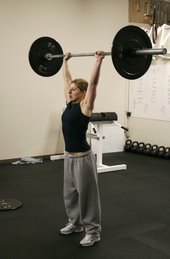We trainer's are so darn smart. We sit down with a new client who, when quizzed about goals, inevitably grabs a flap of flesh and points, "I want to get rid of this!" and then shakes the offending handful a little for emphasis. Where the client sees fat, we see an opportunity to educate. How cute, we think. We're going to have the 'you can't spot reduce' conversation now and the client will be wowed by physiology and my command of it. How cute, the client thinks. The trainer is wrong again.
It turns out that you CAN spot reduce. It's minutia really so I wouldn't get worked up and dust off your thigh master just yet. It's notable, however, that many folks in the industry still have only some of the answers but all of the pomposity. Hopefully we'll be able to spot-reduce fat-headedness. Here's the data on the study:
Are blood flow and lipolysis in subcutaneous adipose tissue influenced by contractions in adjacent muscles in humans?
Bente Stallknecht1, Flemming Dela1, and Jorn Wulff HelgeUniversity of Copenhagen, Copenhagen, Denmark
Aerobic exercise increases whole-body adipose tissue lipolysis, but islipolysis higher in subcutaneous adipose tissue (SCAT) adjacent to contracting muscles than in SCAT adjacent to resting muscles? Ten healthy, overnight-fasted males performed one-legged knee extension exercise at 25% of maximal workload (W max) for 30 minutes followed by exercise at 55% Wmax for 120 minutes with the other leg and finally exercised at 85% Wmax for 30 minutes with the first leg.Subjects rested for 30 minutes between exercise periods. Femoral SCAT bloodflow was estimated from washout of 133Xe and lipolysis was calculated fromfemoral SCAT interstitial and arterial glycerol concentrations and blood flow.
In general, blood flow as well as lipolysis was higher in femoral SCAT adjacent to contracting than adjacent to resting muscle (time 15-30 min: blood flow: 25% Wmax: 6.6 ± 1.0 vs. 3.9 ± 0.8 ml 100 g-1 min-1, P < class="blsp-spelling-error" id="SPELLING_ERROR_16">Wmax: 7.3 ± 0.6 vs. 5.0 ± 0.6, P <> 0.05; lipolysis: 25% Wmax: 102 ± 19 vs. 55 ± 14 nmol 100 g-1 min-1, P = 0.06; 55% Wmax: 86 ± 11 vs. 50 ± 20, P > 0.05; 85% Wmax: 88 ± 31 vs. -9 ± 25, P <>
In conclusion, blood flow and lipolysis are generally higher in SCAT adjacent to contracting than adjacent to resting muscle irrespective of exercise intensity. Thus, specific exercises can induce "spot lipolysis" in adipose tissue.
This topic was tossed about in Performance Menu in the forum some time ago but I just got around to mention it. This is interesting stuff but still no cause to flap flesh at me. Use your words.
skip to main |
skip to sidebar








A conversation with my clients about exercises, work-outs and nutrition
Search This Blog

About Me
- Heather
- I'm an NSCA-PT and CrossFit certified personal trainer with nine years experience. I hold a purple belt in Brazilian Jiu Jitsu under Marcelo Alonso and Ben Blackstone and I am a Karnataka State Gold Medalist in Weightlifting.

Books
Brain Rules: 12 Principles for Surviving and Thriving at Work, Home, and School Food Politics: How the Food Industry Influences Nutrition, and Health, Revised and Expanded Edition (California Studies in Food and Culture)
Food Politics: How the Food Industry Influences Nutrition, and Health, Revised and Expanded Edition (California Studies in Food and Culture) Good Calories, Bad Calories: Fats, Carbs, and the Controversial Science of Diet and Health (Vintage)
Good Calories, Bad Calories: Fats, Carbs, and the Controversial Science of Diet and Health (Vintage) The Omnivore's Dilemma: A Natural History of Four Meals
The Omnivore's Dilemma: A Natural History of Four Meals Practical Programming for Strength Training
Practical Programming for Strength Training PROTEIN POWER
PROTEIN POWER Secrets of the Soil : New Solutions for Restoring Our Planet
Secrets of the Soil : New Solutions for Restoring Our Planet Starting Strength (2nd edition)
Starting Strength (2nd edition) The Brain Trust Program: A Scientifically Based Three-Part Plan to Improve Memory, Elevate Mood, Enhance Attention, Alleviate Migraine and Menopausal Symptoms, and Boost Mental Energy
The Brain Trust Program: A Scientifically Based Three-Part Plan to Improve Memory, Elevate Mood, Enhance Attention, Alleviate Migraine and Menopausal Symptoms, and Boost Mental Energy Fiber Menace: The Truth About the Leading Role of Fiber in Diet Failure, Constipation, Hemorrhoids, Irritable Bowel Syndrome, Ulcerative Colitis, Crohn's Disease, and Colon Cancer
Fiber Menace: The Truth About the Leading Role of Fiber in Diet Failure, Constipation, Hemorrhoids, Irritable Bowel Syndrome, Ulcerative Colitis, Crohn's Disease, and Colon Cancer The Revolution Will Not Be Microwaved: Inside America's Underground Food Movements
The Revolution Will Not Be Microwaved: Inside America's Underground Food Movements The Zone: A Dietary Road Map to Lose Weight Permanently : Reset Your Genetic Code : Prevent Disease : Achieve Maximum Physical Performance
The Zone: A Dietary Road Map to Lose Weight Permanently : Reset Your Genetic Code : Prevent Disease : Achieve Maximum Physical Performance Twinkie, Deconstructed: My Journey to Discover How the Ingredients Found in Processed Foods Are Grown, Mined (Yes, Mined), and Manipulated into What America Eats
Twinkie, Deconstructed: My Journey to Discover How the Ingredients Found in Processed Foods Are Grown, Mined (Yes, Mined), and Manipulated into What America Eats Mind the Gap: The Science Behind the Sporting Mind
Mind the Gap: The Science Behind the Sporting Mind Extraordinary Knowing: Science, Skepticism, and the Inexplicable Powers of the Human Mind
Extraordinary Knowing: Science, Skepticism, and the Inexplicable Powers of the Human Mind The Subtle Body: An Encyclopedia of Your Energetic Anatomy
The Subtle Body: An Encyclopedia of Your Energetic Anatomy Stumbling on Happiness
Stumbling on Happiness
Products


Resources
- Art DeVany
- Brain Health
- Buy Kettlebells
- CrossFit Eastside
- CrossFit Main Page
- Dr. Cordain's Research
- Dr. Eades
- Dr. Ladd Carlston
- Dr. Randip Singh
- Environmental Working Group
- Food, Farming & Healing Arts
- Get Up! Newsletter
- Health Geek's Wikipedia
- Homework for 10a Class
- Jennifer Adler M.S., C.N.
- Marcelo Alonso BJJ
- Michael Pollan
- O'Lifting Coach Mike Burgener
- Predictably Irrational
- Robb Wolf
- TED: Ideas Worth Spreading
- THIS IS THE PREFERRED MEAL TRACKER
- Tim Ferriss, 4 Hour Work Week


